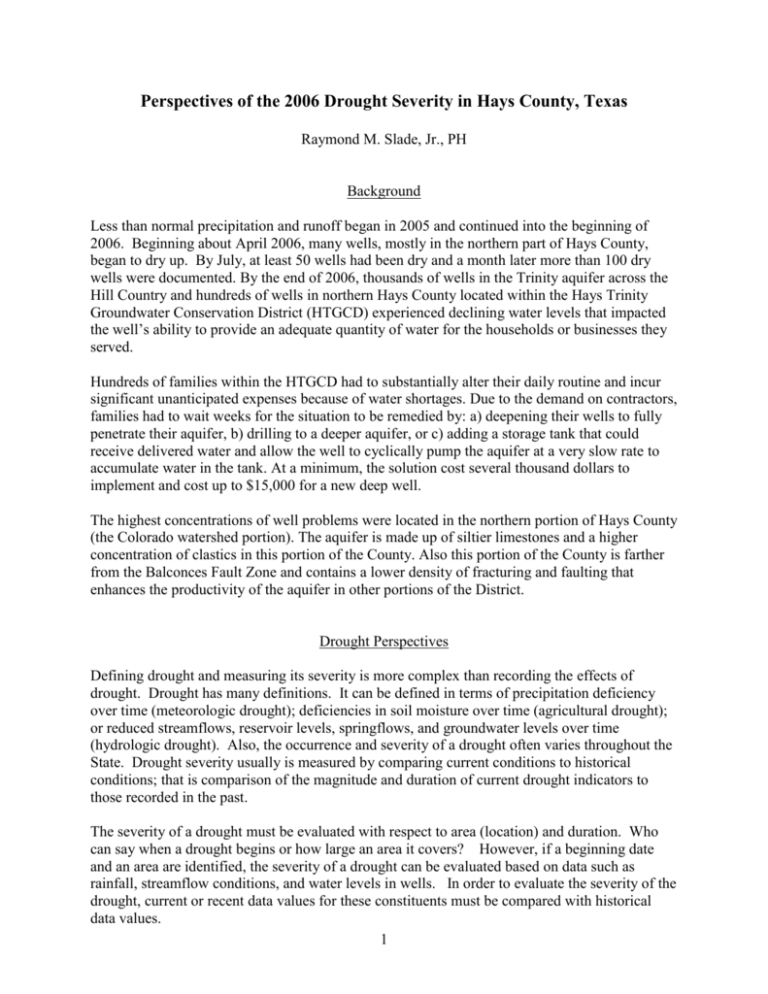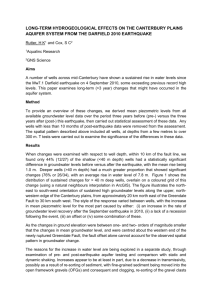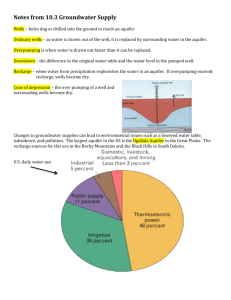Perspectives of the 2006 Drought Severity in Hays County, Texas
advertisement

Perspectives of the 2006 Drought Severity in Hays County, Texas Raymond M. Slade, Jr., PH Background Less than normal precipitation and runoff began in 2005 and continued into the beginning of 2006. Beginning about April 2006, many wells, mostly in the northern part of Hays County, began to dry up. By July, at least 50 wells had been dry and a month later more than 100 dry wells were documented. By the end of 2006, thousands of wells in the Trinity aquifer across the Hill Country and hundreds of wells in northern Hays County located within the Hays Trinity Groundwater Conservation District (HTGCD) experienced declining water levels that impacted the well’s ability to provide an adequate quantity of water for the households or businesses they served. Hundreds of families within the HTGCD had to substantially alter their daily routine and incur significant unanticipated expenses because of water shortages. Due to the demand on contractors, families had to wait weeks for the situation to be remedied by: a) deepening their wells to fully penetrate their aquifer, b) drilling to a deeper aquifer, or c) adding a storage tank that could receive delivered water and allow the well to cyclically pump the aquifer at a very slow rate to accumulate water in the tank. At a minimum, the solution cost several thousand dollars to implement and cost up to $15,000 for a new deep well. The highest concentrations of well problems were located in the northern portion of Hays County (the Colorado watershed portion). The aquifer is made up of siltier limestones and a higher concentration of clastics in this portion of the County. Also this portion of the County is farther from the Balconces Fault Zone and contains a lower density of fracturing and faulting that enhances the productivity of the aquifer in other portions of the District. Drought Perspectives Defining drought and measuring its severity is more complex than recording the effects of drought. Drought has many definitions. It can be defined in terms of precipitation deficiency over time (meteorologic drought); deficiencies in soil moisture over time (agricultural drought); or reduced streamflows, reservoir levels, springflows, and groundwater levels over time (hydrologic drought). Also, the occurrence and severity of a drought often varies throughout the State. Drought severity usually is measured by comparing current conditions to historical conditions; that is comparison of the magnitude and duration of current drought indicators to those recorded in the past. The severity of a drought must be evaluated with respect to area (location) and duration. Who can say when a drought begins or how large an area it covers? However, if a beginning date and an area are identified, the severity of a drought can be evaluated based on data such as rainfall, streamflow conditions, and water levels in wells. In order to evaluate the severity of the drought, current or recent data values for these constituents must be compared with historical data values. 1 Measures of the 2006 Drought in Hays County Meteorologic conditions Annual precipitation data for several rain gages in the Hays county area indicate the precipitation to average about 24 inches in 2006 for the county (figure 1, at end of report). This annual precipitation was about 6 inches less than the long term annual mean depth of about 33 inches for the area. Two long term precipitation gages exist in the area. Presented in the table below are the station names and associated years of data, along with a comparison of the 2006 Hays County precipitation to the annual rain for the stations. 2006 Hays County Precipitation Compared with Historic Precipitation Precipitation gaging station Austin NWS combined stations San Marcos NWS Years of record through 2005 150 86 Number of years for which 2006 Hays County rain less than value at gage 23 12 Percent of years for which 2006 Hays County rain less than value at gage 15 14 NWS – National Weather Service Based on data for the two long-term precipitation stations above, the 2006 Hays County precipitation of 24 inches has been less than that value 15 percent of the years for the Austin station and 14 percent of the years for the San Marcos station. Therefore, based on long-term precipitation data in the Hays county area, 2006 precipitation is not considered to be a substantially dry year. Standardized Precipitation Index Along with rainfall data, droughts are assessed by a Standardized Precipitation Index, which is updated at the end of each month. The maps present drought conditions by county for the past one, three, and six months, and one and three years—they are available at: http://www.txwin.net/Monitoring/Meteorological/Drought/spi.htm. The standard Precipitation Index for the 2006 calendar year is presented below. Based on the data, the Hays County area was considered to be only moderately dry by the end of 2006. 2 Streamflow Conditions Five streamflow gaging stations are operated by the USGS in the area. Presented in the table below are the station names and associated years of data, along with a comparison, for each station, of the 2006 mean flow to its historic annual mean flow values. Even though much of the Pedernales River basin is west of Hays County, the precipitation in that basin appears to be comparable to that in Hays County (fig. 1). Comparison of 2006 Streamflow Compared with Historic Flow Streamflow gaging station name Bear Ck bl FM 1826 nr Driftwood, TX Onion Ck nr Driftwood, TX Pedernales Rv nr Johnson City, TX Blanco Rv at Wimberley, TX Blanco Rv nr Kyle, TX Years of record through 2005 17 26 66 77 49 Number of years for which 2006 flow less than value at gage 0 0 15 8* 0 Percent of years for which 2006 flow less than value at gage 0 0 23 10 0 * Note: 7 of these 8 years occurred before the Blanco River near Kyle station was installed Based on the 3 above stations with the least historic record, the 2006 mean streamflow was the lowest recorded for each of those stations. However, based on the other two stations, the 2006 flow has been lower 23% of the years for the Pedernales River station and 10 % of the years for the Blanco River at Wimberley station. 3 Perspectives of Short and Long-Term Precipitation and Streamflow Data The above analysis concludes 2006 streamflow to be the lowest recorded in the recent past but not to be substantially dry based on longer term data. In an attempt to better quantity this conclusion, recent period meteorologic and hydrologic conditions were compared to those for older periods. This was done by comparing annual precipitation and streamflow data for the past 30 year period to that for the 30 preceding year period. Such data for the San Marcos precipitation station and the two local streamflow stations with at least 60 years of data are summarized in the table below. Comparison of precipitation and flow data for past 30-year period with preceding 30-year period Precipitation or Streamflow station San Marcos NWS rain gage Pedernales Rv nr Johnson City Blanco Rv at Wimberley Mean annual rain or flow value for 30-year period 1946-75 (inches or ft3/s) 32.96 162 122 Mean annual rain or flow value for 30-year period 1976-2005 (inches or ft3/s) 37.05 241 186 Percent by which recent period rain or flow value exceeds older period value 12 49 52 The table above shows that streamflow volume has been about 50 percent greater for the past 30 year period than the 30-year preceding period. Furthermore, for the Pedernales River station, the driest year for the recent 30-year period (1976-2005) was in 1982 with a mean flow of 61 ft3/s, which was equal to the 2006 flow at the station. However, the preceding 30 year period (194675) produced 12 years with flows less than 61 ft3/s for this station. For the Blanco River at Wimberley station, the recent 30-year period produced only one year with flow less than the 2006 flow, however, the preceding 30-year period had 5 years with flow less than the 2006 value. Therefore, 2006 flow conditions were severely low based on recent (about 30 years) historical data but not severely low based on earlier data. Groundwater Conditions The Texas Water Development Board presents recent and historic water level data for wells throughout much of Texas on the Internet at http://www.twdb.state.tx.us/data/waterwells/default.asp. Even though 3 such wells exist in Hays County, only one of those wells has historic data preceding 2006. A water level hydrograph for that well (57-63-705) is presented below. 4 As the data indicate, water levels dropped throughout 2006 but levels in recent preceding years have been lower than those in 2006. A shown in figure 1, the well is located in the southwest part of Hays County. In addition the USGS has recent and historic water levels in an Edwards aquifer well in southeast Hays County (figure 1). The water levels for this well, 67-01-809, are presented below. As the hydrograph shows, water levels have been comparable or lower than those in 2006 for many years since data collection began in 1938. 5 The Hays Trinity Groundwater Conservation District measures monthly water levels from a network of wells. The data and map showing well locations is on the Internet at http://haysgroundwater.org/?module=page&p=Well%20Monitoring, and a map showing the well locations is presented in figure 2. This network probably represents the best database by which to compare 2006 groundwater levels with those for historic conditions. Water level hydrographs are presented for 9 wells in Hays County (figures 3-5)--three of the wells are in the southern part of the county remote from the highest growth and development areas: three are in the mid part of the county; and three are in the north part of the county and proximate to the highest growth areas near Dripping Springs and along Highway 290. Based on information from the HTGCD, the Woodcreek and Camp Ben McCulloch wells are developed in the Lower Trinity aquifer and the remaining wells are in the Middle Trinity aquifer. Affects of Increased Groundwater Withdrawals on Streamflow and Groundwater Based on the drought measures above, the drought is less severe than many past droughts. However, why are so many wells, even those drilled decades ago, now dry for the first time? Most of the known dry wells are in northern Hays County, where unprecedented growth has been occurring the past few years and continues to occur. The unprecedented water level declines in that area are due to substantial pumpage increases associated with the growth. A review of the State Well Reports (driller’s logs) for a significant sample of the wells on record in the northern half of the District reveals three possible answers. 1. Many older wells (pre 1995) do not fully penetrate the aquifer in which they are completed. This creates a situation were a well goes dry much sooner than the full thickness of the aquifer goes dry. The not fully penetrating wells may have been a result of home builders and buyers trying to minimize initial costs during construction. 2. Many wells are not completed in the most productive intervals of the aquifer. The geologic characterization work that Al S. Broun, P.G., HTGCD District Geologist, has done indicates that the Cow Creek Limestone is probably the most consistent “good producer” within the Middle Trinity Aquifer across the District. However, this unit is the deepest unit within the Middle Trinity, therefore folks trying to economize would apparently ask their driller to stop at first sign of “adequate” water in the Lower Glen Rose limestone or the Hensell sand, which are shallower, more prone to drought effects and generally less productive geologic units of the Middle Trinity aquifer due to their higher silt and clay content (higher clastic content). 3. Most of the older wells only have a surface annular casing seal. For example, a 350-foot deep well may only have 20-feet of surface casing in it and have an “open hole completion” which then drains every water bearing geologic unit penetrated, instead of just the aquifer they are targeting. This situation would divert water that would otherwise discharge to springs and streams into wells. It would also divert groundwater that would have otherwise flowed to a shallower neighbor’s well into a deeper well, making the shallower well experience declining water-levels sooner than it historically would have 6 Finally, much of the recent growth represents high density developments with small lot sizes-these areas contain many wells in small areas. The Trinity aquifer in Hays County contains substantial volumes of water however, the water bearing properties of the Trinity aquifer are quite variable and severely limit water production from some areas. Therefore, the well problems are caused by well densities that exceed the aquifers’ ability to produce water at residential demand levels which results in declining water-levels. Surface water The flow for Onion Creek was much lower than expected based on flows for all other creeks in the area. For example, prior to November 1, 2005, no flow had occurred at the gage for only121 days (only 1 percent of the time) since the gage was activated on July 1, 1979. However, during 2006, no flow occurred on all but 35 days, or 91 percent of the time. Furthermore, no flow for the Onion Creek station began in November, 2005, long before the drought became serious based on other streamflow stations. For example, on November 1, 2006 (when Onion became no flow), discharge for the Blanco River stations were only slightly below the median flows for that date, as was the flow for the Pedernales River station. An obvious trend in reduced streamflow has occurred in Onion Creek during or before 2006. Historic streamflow gain/loss data collected on Onion Creek from Ranch Road 12 to the mouth document that Onion Creek’s base flow was sustained by gains in flow in the stream channel (Slade and others, 2002). These gains represent discharges from the Trinity aquifer in topographic low areas adjacent to the streambed in Hays County upstream from Ranch Road 150. However, recent substantial increases in groundwater pumpage in northern Hays County (in the Onion Creek basin) have caused groundwater levels to decline, presumably to the point where the groundwater levels no longer sustain low flow in Onion Creek. Because of the increased groundwater withdrawals in the area, it is expected that Onion Creek will experience no flow conditions for all but storm runoff periods in the future. Groundwater Based on the water level hydrographs for the 9 HTGCD wells, wells in the northern part of the aquifer (proximate to the highest growth areas) generally have experienced water-level drawdown much greater than those in the south part of Hays County and remote from the highest development. These data provide evidence that increased withdrawals associated with increased growth are causing substantial water-level declines in the Trinity aquifer in northern Hays County. Further evidence of this conclusion is presented in a map that presents, for each HTGCD well with data, the difference between the lowest water level in 2006 and the highest level in 2005 (figure 6). 7 Future Projected Water Availability The Hays Trinity Groundwater Conservation District was created in 1999 because the State had declared the area part of the Hill Country Priority Groundwater Management area (PGMA) during 1990. Being part of a PGMA means that the State has forecast impending critical groundwater shortages for the area. Groundwater districts provide local control of groundwater resources through an elected board and are the State’s preferred means of managing groundwater resources because of the local control they provide. State law requires the creation of Groundwater Conservation Districts within PGMAs. The HTGCD’s has unique enabling legislation that does NOT allow the District to establish well spacing for single family residential wells as most other GCDs are empowered to do. These wells constitute the vast majority of wells (about 6,500) in the district and about one half of the district’s water useage. Well spacing within the District is controlled by County lot sizing rules that are driven by septic system criteria with no consideration of the aquifer’s carrying capacity. Many new wells are being drilled in the HTGCD area. During 2004, 159 new wells were drilled, followed by 213 new wells in 2005 and 287 new wells in 2006. Based on population projections, the number of new wells for 2007 and the future is expected to continue to increase. The Texas Water Development Board (TWDB) presents current and projected planning data for water planning strategies in the 2007 Texas Water Plan on the Internet at http://www.twdb.state.tx.us/publications/reports/State_Water_Plan/2007/2007StateWaterPlan/20 07StateWaterPlan.htm. The table below presents projections for population, total water demand, and total water needs for Hays County. Very little surface water is used in Hays County. The TWDB database indicates that only 27,400 acre-feet per year of groundwater are available in the County, of which about 14,000 acre-feet per year can be obtained for water supplies. The total water needed category represents water volumes needed but not available as of now. Hays County Population Year or population projection Total Water Demand Total water needed (acre-feet per year) (acre-feet per year) 2000 97,589 2010 166,342 2020 242,051 2030 302,795 2040 363,678 16,368 31,722 44,772 54,562 64,561 2,368 17,722 30,722 40,562 50,561 Based on these data, the water demand for Hays County will substantially increase in the near future. Additionally, data from the Texas State Data Center and Office of the State Demographer (http://txsdc.utsa.edu/tpepp/txpopest.php) predict Hays County will have much greater future population than projected here by the TWDB. Hays County is one of the fastest growing counties in the State--recent populations for Hays County have exceeded past population projections, and this trend might continue because of unprecedented growth in the County. Therefore, the water needs for the County could be greater than indicated in the table above. 8 Conclusion Precipitation and streamflow data for 2006 indicate dry conditions in Hays County, but not sufficiently dry to account for the unprecedented groundwater availability problems experienced in high developed areas in the northern part of the aquifer. Furthermore, ground water levels in 2006 generally were near or only slightly below normal conditions for wells remote from developed areas in the County. Substantial rainfall and runoff in 2007 have caused many of the water levels to recover, thus the problem is temporarily solved. However, the drought has been and eventually will be much worse, and much more development is projected for the County. Future worse droughts and additional growth will cause many more wells to become dry and probably result in many thousands of people in the County to be without water. Nobody knows when this will happen, but it is likely to occur in the near future. References Slade, R.M., Jr., Bentley, T., and Michaud, D., 2002, Results of streamflow gain-loss studies in Texas, with emphasis on gains from and losses to major and minor aquifers: U.S. Geological Survey Open-File Report 02-068, DC-ROM. http://pubs.usgs.gov/of/2002/ofr02-068/ 9 10 11 Figure 3. Water-Level Hydrographs for Wells in Northern Hays County 12 Figure 4. Water-Level Hydrographs for Wells in Central Hays County 13 Figure 5. Water-Level Hydrographs for Wells in Southern Hays County 14 15









